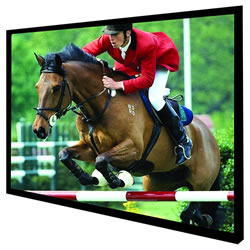 |
CRT Primer
|
Updated: April 2006 |
Screen Gain
Commercially available screens come in various screen ‘gains’, i.e. how much
light they reflect back at you. Generally, CRT’s are best suited for screen
gains 1.8 or less.
Higher gain screens tend to develop ‘hot spots’, so that
sections of the image look brighter than another. As well, the higher the
screen gain, the more the viewing angle is limited. That’s fine if you alone are watching the projector,
but if a group of friends are over to watch sports, the ones off axis to the
screen will get a lower brightness level.
Most of the screens that we sell are Draper 1.3 gain, and they have worked
out fine in all applications. Da-lite and Stewart are also popular screen
manufacturers.
High gain screens are usually also known as glass bead, and will not work
properly with CRT projectors. These are the screens also used for movie and
slide projectors, so if you have an old tripod screen gathering dust that you
want to use for a CRT projector, you’re better off letting it continue to gather
dust and spring for a new matte white A/V screen.
Note that if you find a used screen, and do not know if it is glass bead or
not, run your fingernail over the surface of the screen. If it feels smooth or
like canvas, then it is fine. If it feels like sandpaper, then it is a glass
bead and cannot be used.
Some digital users switching over to CRT have asked me if their grey screens
will work with their CRT projectors. I'm afraid not: These special
screens have a grey(ish) colour to them to help digital projectors display
better blacks (since most digitals are unable to display true black). CRT
projectors do not have this problem and cannot be adjusted to work correctly
with grey screens. Sorry!
|
|


